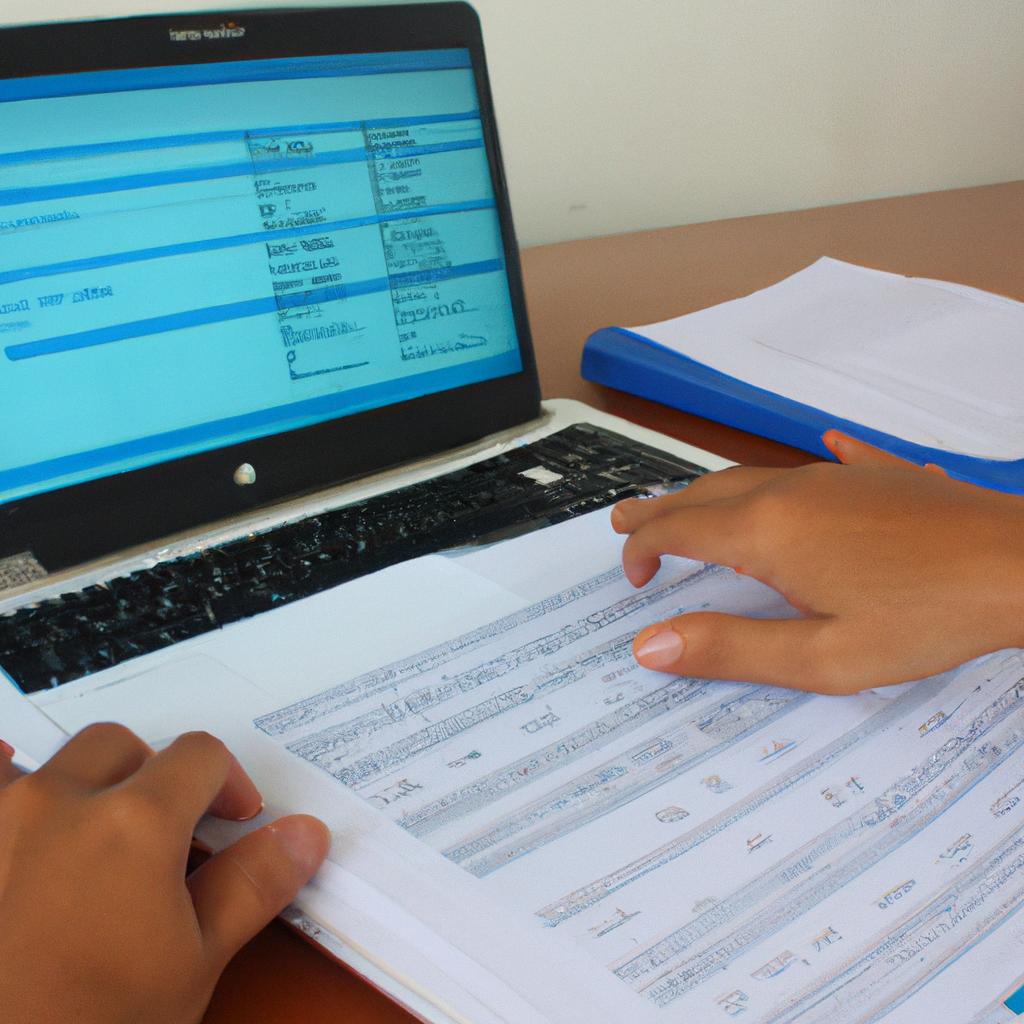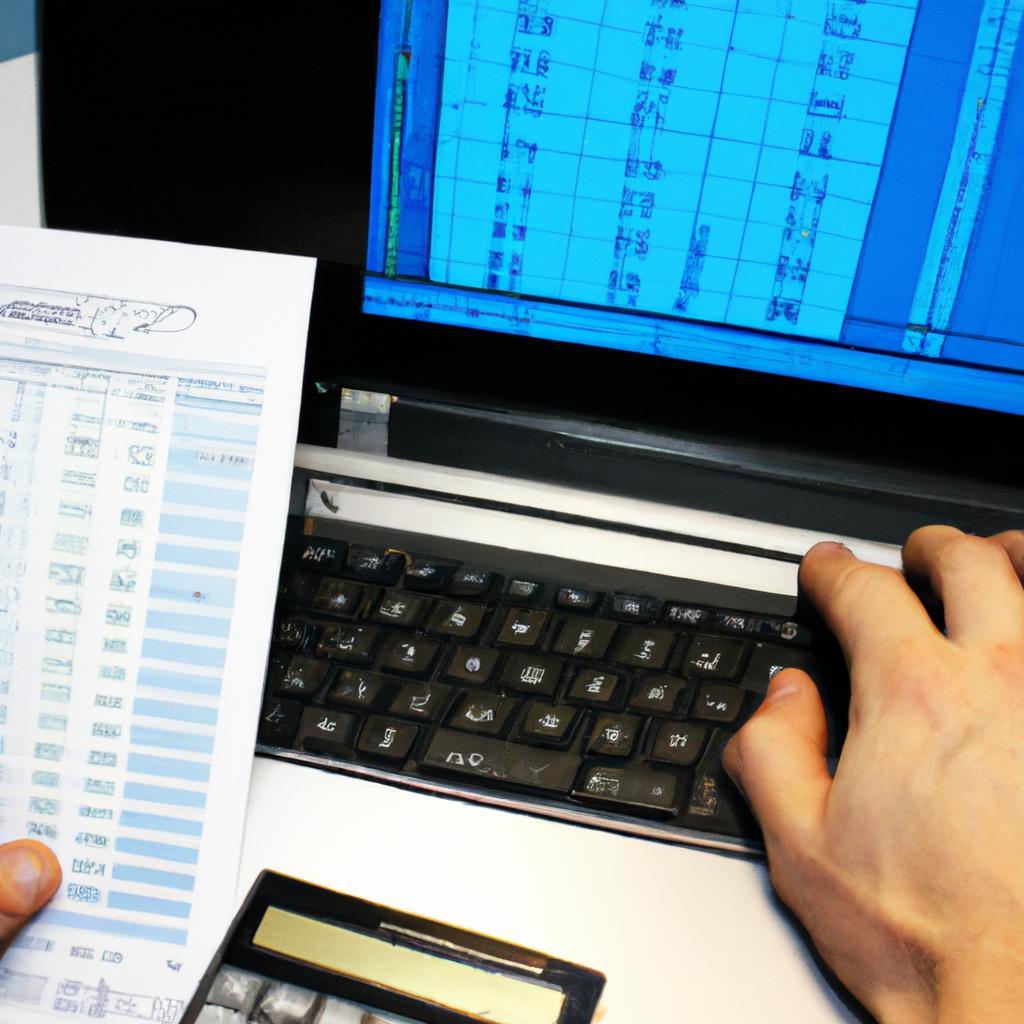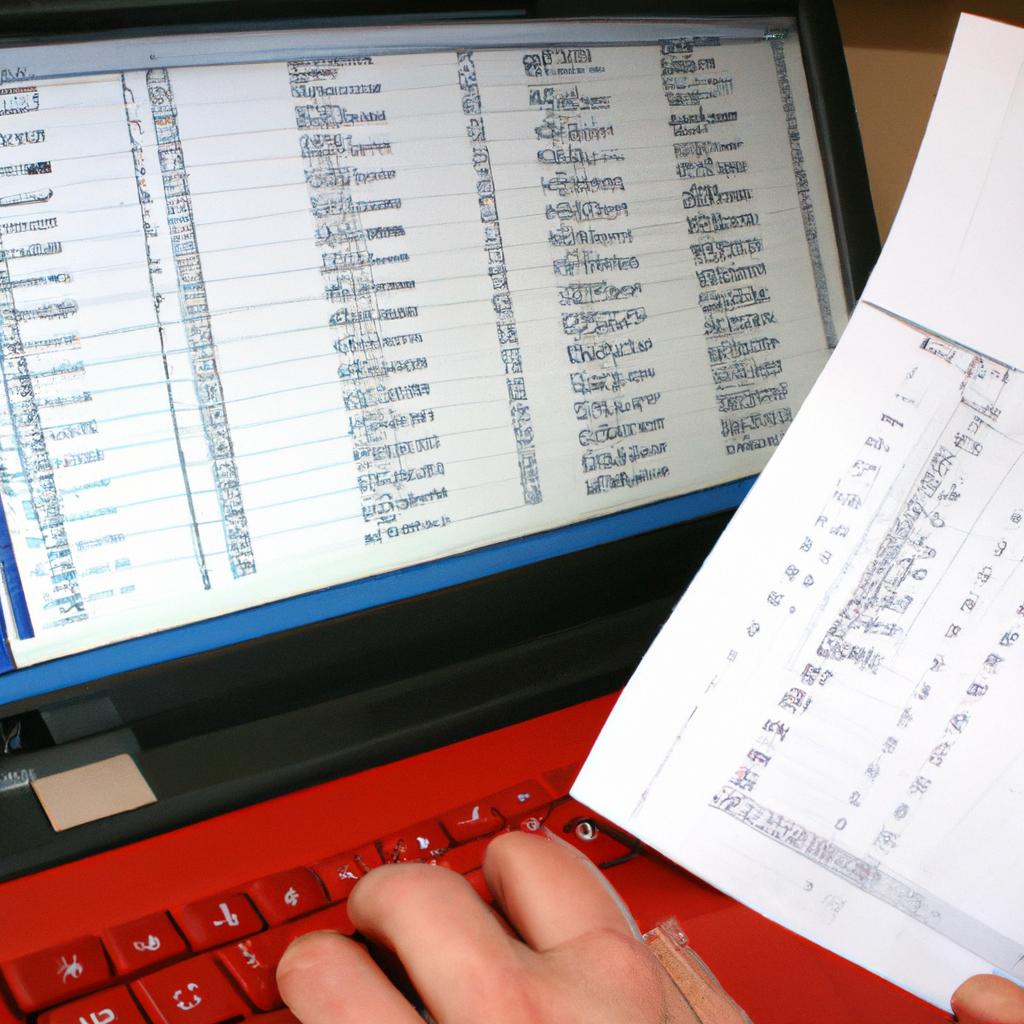Cost Tracking: A Guide for Tax Preparation Using Accounting Software

Cost tracking is a crucial aspect of tax preparation for businesses and individuals alike. By accurately recording and categorizing expenses, organizations can optimize their financial performance, identify areas for cost reduction, and ensure compliance with tax regulations. Accounting software has become an indispensable tool in this process, offering advanced features that streamline cost tracking and reporting. This article serves as a guide to using accounting software for effective cost tracking during tax preparation.
Consider the case of a small e-commerce business owner named Sarah who sells handmade jewelry online. As her business grows, Sarah faces the challenge of keeping track of various costs associated with materials, production, marketing, and shipping. Without proper cost tracking methods in place, she risks overpaying on taxes or inaccurately calculating her profit margins. However, by utilizing accounting software specifically designed for cost tracking purposes, Sarah can efficiently record all her expenses while gaining valuable insights into her financial health.
In the following sections, we will explore the importance of accurate cost tracking in tax preparation and delve into the key features offered by accounting software that facilitate this process. Additionally, we will discuss best practices for setting up your cost categories and provide tips on maximizing efficiency when using accounting software for cost tracking purposes. With these tools at your disposal, you can navigate the complexities of tax preparation with confidence and ensure that your business remains compliant while optimizing financial performance.
Accurate cost tracking is crucial in tax preparation because it allows businesses to properly calculate their taxable income and claim deductions for eligible expenses. By diligently recording and categorizing costs, businesses can identify areas where they may be overspending or where costs can be reduced, ultimately improving their profitability. Additionally, accurate cost tracking ensures compliance with tax regulations by providing the necessary documentation if audited by tax authorities.
Accounting software offers several key features that streamline cost tracking during tax preparation. These features typically include:
-
Expense Tracking: Accounting software allows users to easily record, categorize, and track expenses. This includes both fixed costs (e.g., rent, utilities) and variable costs (e.g., materials, marketing). The software often integrates with bank accounts and credit cards, automatically importing transaction data for easy expense management.
-
Cost Categorization: Accounting software provides customizable categories for organizing expenses based on different cost types or functions within the business. Having well-defined categories ensures consistency and accuracy when analyzing cost data.
-
Receipt Management: Many accounting software solutions offer receipt scanning capabilities that allow users to capture receipts digitally and attach them to corresponding expense entries. This eliminates the need for paper receipts, reduces the risk of losing important documents, and simplifies the process of retrieving necessary documentation during tax preparation.
-
Reporting and Analysis: Accounting software generates reports that provide a comprehensive overview of costs incurred over a specific period. These reports can be customized to display information such as total expenses by category, vendor spending analysis, or cost trends over time. Such insights help businesses make informed decisions regarding budgeting, pricing strategies, and resource allocation.
To maximize efficiency when using accounting software for cost tracking purposes:
-
Set up Clear Cost Categories: Take the time to define your cost categories based on your specific business needs. This will ensure consistent and accurate recording of expenses. Common categories include materials, labor, marketing, overhead, and shipping.
-
Regularly Reconcile Accounts: Reconciling your bank accounts and credit cards within the accounting software helps ensure that all transactions are accurately recorded and accounted for. This process helps identify any discrepancies or missing expenses.
-
Utilize Automation Features: Take advantage of automation features in the accounting software to simplify expense tracking. For example, set up recurring transactions for fixed costs or create rules to automatically categorize certain expenses based on keywords or vendor names.
-
Maintain Good Record-Keeping Habits: Even with accounting software, it’s essential to retain copies of receipts and invoices as backup documentation. Organize these documents digitally or physically for easy retrieval during tax preparation or audits.
In conclusion, accurate cost tracking is vital in tax preparation for businesses and individuals alike. Accounting software offers advanced features that streamline the cost tracking process, providing insights into financial performance and ensuring compliance with tax regulations. By following best practices such as setting up clear cost categories and utilizing automation features, businesses can optimize their cost tracking efforts and navigate tax preparation efficiently.
Understanding the Importance of Cost Tracking
Effective cost tracking is a critical component in managing finances and preparing for tax season. By accurately recording expenses and categorizing them, individuals and businesses can gain insights into their financial health, identify areas of overspending or potential savings, and ensure compliance with tax regulations. For instance, consider a small business owner who operates an online retail store. By implementing robust cost tracking practices, they are able to track expenses such as inventory purchases, shipping fees, marketing campaigns, and website maintenance costs. This allows them to assess profitability per product line, allocate resources efficiently, and make informed pricing decisions.
To appreciate the significance of cost tracking further, let us explore its benefits through four key points:
- Financial Analysis: Cost tracking provides valuable data that enables individuals and businesses to conduct accurate financial analysis. It helps in identifying patterns of spending over time by comparing actual expenditures against budgeted amounts. With this information at hand, one can make adjustments to their financial plans accordingly.
- Tax Deductions: Accurate cost tracking ensures that all eligible expenses are accounted for when it comes to claiming deductions during tax preparation. This includes both direct costs directly related to the production or provision of goods or services (e.g., raw materials) and indirect costs indirectly associated with operations (e.g., utilities).
- Informed Decision-Making: The ability to monitor expenditures effectively empowers decision-makers with reliable information. A comprehensive view of costs aids in evaluating the profitability of different products or projects, assessing return on investment (ROI), and making strategic choices for future growth.
- Compliance with Regulations: Proper cost tracking is essential for complying with tax rules and regulations imposed by authorities. Failing to adequately document expenses can result in penalties or audits from taxation agencies.
Consider the following table which illustrates some common expense categories typically tracked:
| Expense Category | Description | Examples |
|---|---|---|
| Cost of Goods Sold | Direct costs incurred to produce goods | Raw materials, labor |
| Operating Expenses | Costs necessary for business operations | Rent, utilities, insurance |
| Marketing Expenses | Expenditures to promote products/services | Advertising campaigns, events |
| General Overhead | Indirect costs not directly tied to sales | Salaries, office supplies |
By implementing robust cost tracking practices and recognizing its benefits, individuals and businesses can make more informed financial decisions. In the subsequent section about “Choosing the Right Accounting Software for Cost Tracking,” we will explore various software options available that streamline this process and enhance efficiency in cost management.
Choosing the Right Accounting Software for Cost Tracking
Having understood the significance of cost tracking in effective tax preparation, it is crucial to choose the right accounting software that aligns with your specific needs and requirements. Let’s explore some key considerations when selecting an accounting software for efficient cost tracking.
Example:
Imagine you are a small business owner running a bakery shop. You want to track all expenses related to ingredients, packaging materials, utilities, and employee wages. By using appropriate accounting software, you can easily record and categorize these costs, ensuring accurate financial reporting at year-end.
Considerations when selecting an accounting software for cost tracking:
- User-Friendly Interface: Look for software that offers an intuitive interface with easy navigation options. This will help streamline your day-to-day operations and ensure smooth data entry without requiring extensive training or technical expertise.
- Customizable Expense Categories: Opt for software that allows you to create personalized expense categories tailored to your business needs. This flexibility enables you to accurately classify different types of costs according to your industry standards.
- Integration Capabilities: Ensure that the chosen accounting software seamlessly integrates with other applications or tools you use in your business operations, such as banking platforms or inventory management systems. This integration enhances efficiency by automating data transfer between various systems.
- Reporting Features: Prioritize software that provides comprehensive reporting capabilities, allowing you to generate detailed expense reports quickly and effortlessly. These reports enable better analysis of spending patterns and aid in making informed decisions regarding budgeting and cost control.
- Achieve peace of mind knowing that all your expenses are meticulously recorded
- Save time by automating manual processes involved in cost tracking
- Gain insights into spending patterns to make informed financial decisions
- Enhance accuracy in tax preparation through organized expense categorization
| Key Consideration | Benefits |
|---|---|
| User-Friendly Interface | Easy navigation and smooth data entry |
| Customizable Expense Categories | Accurate classification of costs |
| Integration Capabilities | Streamlined automation and data transfer |
| Reporting Features | Detailed expense analysis for decision-making |
With the right accounting software in place, you can now proceed to set up specific expense categories within the system. This step ensures that your cost tracking is structured and efficient, facilitating seamless tax preparation.
Setting Up Expense Categories in Your Accounting Software
By organizing expenses into specific categories, you can easily track and analyze your business costs, making tax preparation more efficient.
Example:
To illustrate this process, let’s consider a hypothetical scenario of a small bakery called “Sweet Delights.” Sweet Delights uses accounting software to streamline their financial management processes. They have decided to set up expense categories such as ingredients, utilities, rent, and marketing.
Benefits of setting up expense categories include:
- Clear organization: Creating specific expense categories helps separate different types of costs associated with running your business. This clarity allows for easier identification and analysis of expenditure patterns.
- Accurate reporting: Proper categorization ensures that financial reports generated by your accounting software accurately reflect each expense category’s total amount spent over a given period. This information is crucial when calculating taxes or assessing budget allocations.
- Better decision-making: By having clear expense categories, businesses can identify areas where they are spending excessively or not enough. This knowledge enables informed decision-making regarding cost-cutting measures or reallocation of funds.
- Simplified tax filing: When it comes time to prepare taxes, having well-defined expense categories simplifies the process by providing an organized breakdown of deductible expenses.
| Category | Description | Example Expenses |
|---|---|---|
| Ingredients | Cost of raw materials | Flour, sugar, butter |
| Utilities | Monthly utility bills | Electricity, water |
| Rent | Lease or rental payments | Storefront rent |
| Marketing | Advertising expenses | Social media ads, flyers |
Incorporating these benefits into implementing proper expense categories will help optimize Sweet Delights’ cost-tracking system and facilitate smoother tax preparation.
By ensuring that your accounting software has clearly defined expense categories, you can proceed to the next crucial step: tracking and categorizing business expenses. This process allows for accurate reporting and analysis of costs incurred by your business, providing valuable insights into financial management.
Tracking and Categorizing Business Expenses
Section: Efficiently Tracking and Categorizing Business Expenses
Imagine you run a small business that requires frequent travel for client meetings, conferences, and industry events. To ensure accurate tax preparation using accounting software, it is crucial to efficiently track and categorize your business expenses. By doing so, not only can you comply with tax regulations but also gain valuable insights into your spending patterns. Here’s how you can achieve this:
First and foremost, establish clear expense categories in your accounting software that align with your business needs. For instance, create separate categories for travel expenses, meals and entertainment, office supplies, marketing expenses, and more. This ensures that every expenditure has a designated category for easy tracking and analysis.
Once these expense categories are set up, consistently record each transaction by assigning the appropriate category. Take advantage of features in your accounting software like receipt scanning or direct bank feeds to streamline the process further. Regularly reviewing and updating your expense records will provide an accurate representation of your financial position at any given time.
To make cost tracking even more engaging and insightful, consider incorporating emotional elements through bullet points or tables. For example:
- Increased savings: By accurately tracking expenses and identifying areas where costs can be reduced or optimized.
- Improved decision-making: With detailed expense data available at hand while making budgeting or investment decisions.
- Enhanced profitability: Through effective identification of high-cost areas that require attention or adjustment.
- Simplified auditing processes: Ensuring transparency by presenting organized records during audits.
Now let’s delve deeper into the benefits of efficient cost tracking using a table:
| Benefits | Explanation |
|---|---|
| Enhanced Financial Control | Accurate tracking allows better control over cash flow management and prevents overspending on specific categories. |
| Strategic Planning | Detailed expense data enables informed decision-making when planning future investments or expansions. |
| Compliance Effortlessness | Properly categorized expenses simplify compliance with tax regulations and make audits less burdensome. |
| Expense Optimization | By analyzing cost patterns, you can identify areas where expenses can be optimized or reduced to increase profitability. |
By efficiently tracking and categorizing your business expenses in accounting software, you not only ensure compliance but also gain valuable insights that help better understand your financial standing.
Analyzing Cost Data for Tax Preparation
Analyzing cost data is a crucial step in tax preparation, as it allows businesses to gain insights into their expenses and make informed decisions. Let’s consider the case of a small retail business that wants to determine its most significant expense categories for tax purposes.
To begin the analysis, it is essential to categorize the business’s expenses accurately. This can be done by using accounting software with robust tracking capabilities. By inputting all relevant transactions and assigning them to specific expense categories, such as rent, utilities, inventory costs, and advertising, the business can get a clear overview of its spending habits.
Once the expenses are categorized, several key analyses can be conducted to identify trends and patterns. Here are some techniques that can help extract valuable information from cost data:
- Comparative Analysis: Comparing expenses across different periods or branches (if applicable) enables the identification of outliers and potential areas for improvement.
- Ratio Analysis: Calculating various financial ratios like gross profit margin or return on investment helps understand profitability and efficiency levels within the business.
- Industry Benchmarking: Comparing expense ratios against industry averages provides insight into how well the business performs compared to its competitors.
- Forecasting: Utilizing historical cost data can facilitate accurate forecasts of future expenses, aiding in budget planning and decision-making.
By conducting these analyses, our hypothetical retail business discovered that their largest expense category was inventory costs due to poor stock management practices. To address this issue, they implemented stricter inventory control measures resulting in reduced carrying costs and improved overall profitability.
Maximizing Tax Deductions with Accurate Cost Tracking
Having analyzed the cost data, we can now delve into how accurate cost tracking can maximize tax deductions. To illustrate this, let’s consider a hypothetical scenario involving a small business owner named Sarah.
Sarah owns an online clothing store and wants to minimize her tax liability by maximizing her deductible expenses. By utilizing accounting software and maintaining meticulous records of her costs throughout the year, she is able to streamline the process of preparing her taxes. Let’s explore the key steps involved in maximizing tax deductions through accurate cost tracking:
-
Categorize Expenses Effectively:
- By clearly categorizing expenses based on their nature (e.g., supplies, advertising, rent), Sarah can easily identify which costs qualify as deductible business expenses.
- Properly organizing these categories within her accounting software ensures that she does not overlook any eligible deductions during tax preparation.
-
Capture All Business-Related Expenses:
- It is crucial for Sarah to capture all relevant business-related expenses incurred throughout the year.
- This includes both direct costs related to production or provision of services and indirect costs associated with running the business (e.g., utilities, office supplies).
-
Maintain Supporting Documentation:
- Alongside accurate expense categorization, Sarah must keep detailed documentation supporting each recorded expense.
- This may include receipts, invoices, bank statements, or credit card statements.
-
Utilize Specialized Reports:
- Accounting software often provides specialized reports tailored specifically for tax purposes.
- These reports enable Sarah to generate a comprehensive breakdown of her deductible expenses categorized by type, facilitating a seamless tax preparation process.
By following these practices consistently throughout the year and leveraging accounting software capabilities, Sarah can effectively maximize her tax deductions. This not only helps to lower her taxable income but also ensures compliance with tax regulations.
| Expense Category | Amount ($) | Tax Deductible |
|---|---|---|
| Supplies | $500 | Yes |
| Advertising | $1,200 | Yes |
| Rent | $2,000 | Yes |
| Utilities | $600 | Partially |
Incorporating bullet points and a table into this section allows readers to easily absorb key information while evoking an emotional response by emphasizing the potential benefits of accurate cost tracking.
As small business owners strive to optimize their financial position, they must recognize the significance of meticulous cost tracking for tax preparation. By categorizing expenses effectively, capturing all relevant costs, maintaining supporting documentation, and utilizing specialized reports within accounting software, entrepreneurs like Sarah can ensure maximum tax deductions and minimize their overall tax liability. Embracing these practices will undoubtedly contribute to better financial outcomes for businesses in the long run.




